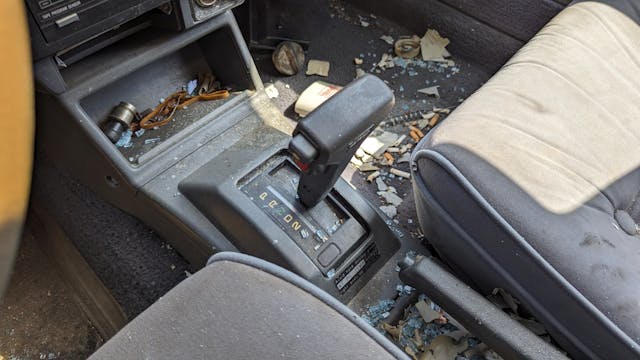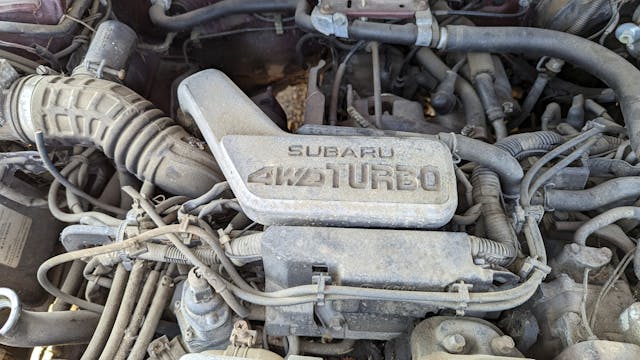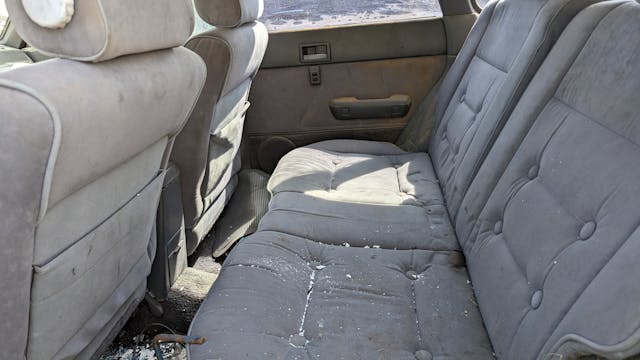Final Parking Space: 1987 Subaru GL-10 Turbo 4WD Wagon
In Colorado, where I live, four-wheel-drive Subarus have been beloved ever since the first 4WD Leone-based models appeared in showrooms in the mid-’70s. Because of their popularity in the Centennial State for nearly 50 years, the car graveyards along the I-25 corridor amount to museums of the history of the Pleiades-badged brand in America. Today we’ll take a look at an absolutely loaded Subaru wagon, found in a boneyard just outside of Denver.

When we talk about U.S.-market Subarus of the 1970s and 1980s, we need to first discuss the way that Fuji Heavy Industries named their cars on this side of the Pacific. The Leone, as it was known in Pacific markets, debuted in the United States as a 1972 model, but that name was never used here. At first, they were designated by their engine displacements, but soon each model was pitched as, simply, “the Subaru” with the trim levels (DL and GL were the best-known) used as de facto model names. The exception to this system was the Brat pickup, which first showed up as a 1978 model. Things in the American Subaru naming world became even more confusing when the non-Leone-derived XT appeared as a 1985 model followed by the Justy two years later, and the Leone finally became the Loyale here for its final years (1990-1994).

The Leone began its American career as a seriously cheap economy car, mocked in popular culture for its small size (but still getting a shout-out from Debbie Harry). Sponsorship of the U.S. Olympic Ski Team and gradual addition of size and features allowed Subaru to sell the higher-end Leone models for decent money as the 1980s went on.

In 1987, the absolute cheapest member of the Leone family in the United States was the base front-wheel-drive three-door-hatchback, coming in at an MSRP of $5857 (about $16,345 in 2024 dollars). Known to Subaru dealers as the STD, it was disappointingly never badged as such.

At the very top of the 1987 U.S.-market Leone ziggurat stood today’s Final Parking Space subject: the GL-10 Turbo 4WD Wagon. Its price started at an impressive $14,688, which comes to a cool $40,990 after inflation. A naturally-aspirated 1987 GL 4WD Wagon could be had for $10,767 ($30,047 in today’s money). In fact, the only way to spend more on a new 1987 Subaru (before options) was to forget about the Leone and buy an XT GL-10 Turbo 4WD at $15,648 ($43,669 now).

There weren’t many options you’d need on the feature-stuffed GL-10, but this car’s original buyer decided it was worth paying an additional $955 ($2665 in today’s bucks) for the automatic transmission. That pushed its out-the-door cost to within spitting distance of the price of admission for a new Volkswagen Quantum Syncro Wagon and its $17,320 ($48,335 in 2024) price.

Subaru was an early adopter of turbocharging for U.S.-market cars, with the first turbocharged Leone coupes and wagons appearing here in 1983. This car has a 1.8-liter SOHC boxer-four rated at 115 horsepower and 134 pound-feet, pretty good power in its time for a vehicle that scaled in at just 2,530 pounds (that’s about 700 fewer pounds than a new Impreza hatchback, to give you a sense of how much bulkier the current crop of new “small” cars is).

Subaru was just in the process of introducing a true all-wheel-drive system as we understand the term today in its U.S.-market vehicles when this car was built, and both 4WD and AWD systems were installed in Subarus sold here from the 1987 through 1994 model years. (Beginning with the 1996 model year, all new Subarus sold in the United States were equipped with AWD.) Subaru fudged the definition on its badging for a while by using a character that could be read as either a 4 or an A, as seen in the photo above.

I’ve documented a discarded 1987 GL-10 Turbo 4WD Coupe that had genuine AWD (called “full-time four-wheel-drive” by Subaru and some other manufacturers at the time), and it had prominent “FULL-TIME 4WD” badging and a differential-lock switch. This car just has the 4WD switch on the gearshift lever, like earlier 4WD Subarus with automatics, so I am reasonably sure that it has a 4WD system that requires the driver to switch to front-wheel-drive on dry pavement in order to avoid damage to tires or worse. But even as the current owner of two Subarus and a longtime chronicler of junked Fuji Heavy Equipment hardware, I cannot say for certain about the weird 1987 model year. Please help us out in the comments if you know for sure!

This car has the sort of science-fiction-grade digital dash that was so popular among manufacturers (particularly Japanese ones) during the middle 1980s.

It also has what a 1987 car shopper would have considered a serious factory audio system, with cassette track detection and a trip computer thrown in for good measure. This stuff was standard on the GL-10 that year, and you needed that righteous radio to fully appreciate the popular music of the time.

The odometer shows just over 120,000 miles, and the interior wasn’t too thrashed, so why was one of the coolest Subaru wagons of the 1980s residing in this place? First of all, there’s a glut of project Leones available in Colorado’s Front Range at any given moment. Second, all of the most devoted enthusiasts of these cars in this region already have hoards stables of a dozen with no space for more; I let my many friends who love these cars know about this one and they plucked at least a few parts from it before it got crushed (sorry, I shot these photos last summer and this car has already had its date with the crusher).

So, if you’re a vintage Subaru aficionado living where the Rust Monster stands 100 feet tall, head to the region between Cheyenne and Colorado Springs and find yourself a project Leone to bring home. We’ve got plenty here!


























***
Check out the Hagerty Media homepage so you don’t miss a single story, or better yet, bookmark it. To get our best stories delivered right to your inbox, subscribe to our newsletters.



I had a GL wagon back in the day, and it was a pretty cool car for a wagon. It was a bit light on the squirrels for my taste, and I always wanted the GL10… until I got my first 5.0 Mustang, then Subarus were a distant speck in my rear view mirror
Murilee, I assume the $ + with down arrow on the sides of the Subaru are some markings that the salvage yard applied. Do you have any idea what they signify?
I’m guessing those are from the place that auctioned it. No idea what they mean.
Okay, thank you.
I suprised the rust monster hasn’t claimed this one. In the late 90’s I attempted to replace the windshield on a GL wagon. As I was removing the moldings before cutting out the glass, the entire windshield popped loose along with a big section of the pinchweld. Needless to say, there was no way a new windshield was going back in. These things started rusting on the showroom floor.
I remember those things. I admit that I never got into this model as a kid. The XT caught my attention but before we got Legacy Turbo, SVX or Impreza WRX I never really got into Subaru. I do recall that Colorado is Subaru country, they are everywhere. I have a friend in Greely and he works for a Subaru dealer out there. it’s a beautiful place.
They have always been pricey.
When I returned to Washington from Texas (big mistake), I noticed just how many of thesr things are out there. If GM had that proportional market share it never would have gone broke.
My nephew had a not too old wagon…it was a write off agyer.hitting a small deer. It was still drivable, but it bent the unibody.
Speaking of stereos what about the 270 watt 8 speaker Diamante VR-X next to it? Although it is missing the boot spoiler, I wonder where that went?
Good eye! I wrote about that VR-X for Autoblog last October: https://www.autoblog.com/2023/10/03/junkyard-gem-2003-mitsubishi-diamante-vrx/